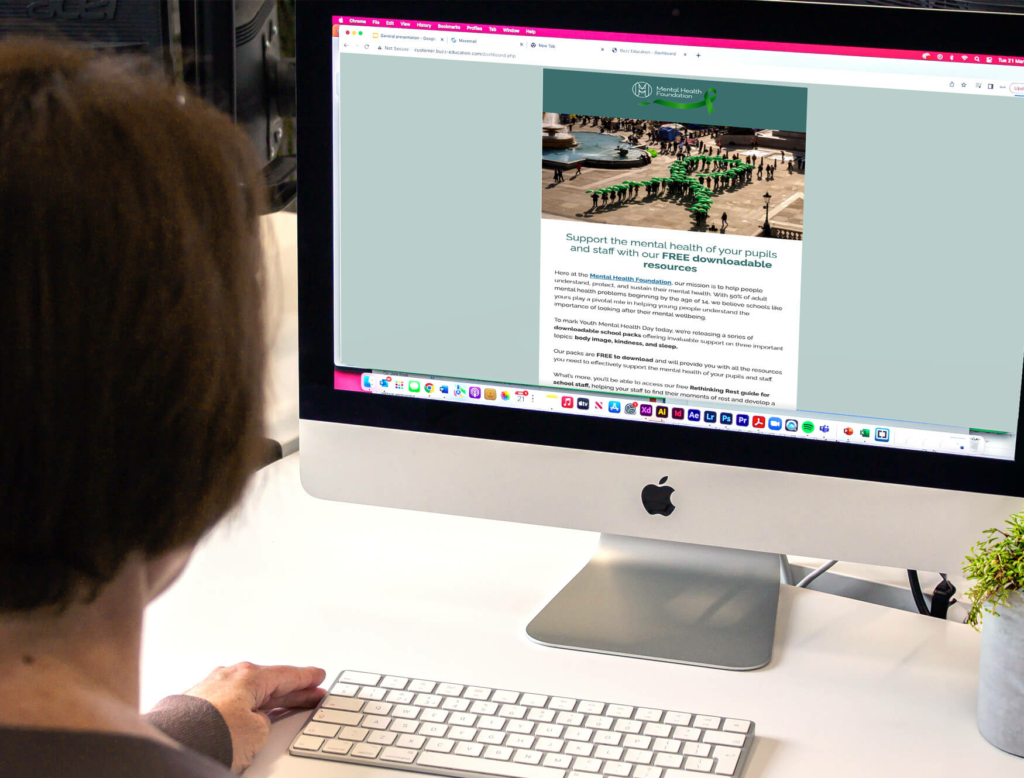


8 tips to write effective marketing emails for teachers

When it comes to marketing to education, email remains one of the most effective ways to connect with your chosen target audience. To make sure your emails stand out, you need to craft messaging that’s clear, relevant and engaging.
As one of Buzz’s education content strategists, I’ve worked with many of our clients to help them create and deliver engaging marketing emails to teachers that build brand awareness and generate more leads.
To help you increase your engagement rates, I’ve collated my 8 top tips for your education marketing emails:
1. Know your audience inside out
The foundation of any successful email campaign is taking the time to understand your target education establishments, teachers and decision makers.
Teachers have unique challenges and needs, which means your emails should be tailored to their specific pain points and priorities to keep them reading.
For example, business managers will look at the cost of your product or service; head teachers want to know why you’re the best choice for their school and subject teachers want to know the benefits for them and their pupils.
I’d also recommend including the benefits of what you’re offering towards the top of the email to quickly and directly tell them how you can help.

Keen to see which decision makers you can connect with?
Get in touch to discover which job roles we’ve got in our database (…there’s a lot!).
2. Craft compelling subject lines
The subject line is the first impression teachers will get of your brand and your marketing message. A well-written subject line should be concise, attention-grabbing, and relevant.
Did you know that 47% of recipients open an email based on the subject line alone? As it’s the first thing a teacher
sees in their inbox, your subject line plays a crucial role in encouraging opens. To increase your engagement rates, follow our Buzz Method recommendations:
- Aim for 6-8 words.
- Use your subject line to highlight a benefit.
- Include action words to inspire curiosity or urgency.
A/B testing different subject lines can also help you to determine what resonates most with your chosen mailing list. Plus, personalising your subject line by job title or contact name is a great way to get your email to the right audience.
Inside Insight: 84% of school secretaries will forward your email to the relevant teacher or decision maker where the subject line is clearly addressed to them, e.g. FAO Head of Science.
3. Provide value from the start
We know that teachers are more likely to engage with your emails if they see immediate value in what you’re offering.
Your email’s opening paragraph is your chance to introduce teachers to your brand and highlight the benefits of your offering and why they should choose to work with you.
Position your product or service as a solution to their everyday challenges. Demonstrate how you can save them time, boost their students’ grades, or make their job easier.

4. Keep your content concise and digestible
Teachers have a limited amount of time. I recommend keeping your message short, to-the-point and clear:
- State the value in the first few lines.
- Use short paragraphs and bullet points to aid readability.
- Stick to one main focus.
- Highlight key information using subheadings or bold text.
Through our regular campaign analysis, we’ve discovered that emails between 250-400 words work best for engagement. It gives teachers the perfect amount of information to understand what you offer, how you can help, and encourage them to click through to your website.
5. Use testimonials to build trust
Our analysis shows that including testimonials in your email campaigns can increase engagement rates by up to 30%. That’s why it’s important to include success stories, testimonials and case studies to showcase how your product or service has positively impacted other schools or teachers.
In our School Survey, 100% of teachers said they look for good reviews and testimonials from other teachers when they’re looking at a new product or service.
Testimonials and case studies can act as a reminder of how great your offering is and help to build trust, so they’re a vital way to gain new leads and conversions.
6. Personalise your content
We know that teachers appreciate emails that feel conversational and friendly. You can do this by addressing them on a personal level – by their name and job title, or by referencing their school name.
Plus, our analysis shows that using personalisation in your email can boost your click through rates by up to 46%. We also recommend personalising your content by acknowledging their challenges and framing your product or service with plenty of benefits.
7. Clear call to action buttons (CTA)
Every marketing email should have a clear call to action (CTA) that tells teachers exactly what you want them to do. Whether you’re asking teachers to download a free resource or sign up to a webinar, make sure your CTA is:
- Action-oriented (e.g. Don’t miss out or Download now)
- Visually prominent (use buttons and bold text)
- Limited to two main calls to action per email to avoid confusion
Our analysis shows that CTAs including the word ‘free’ get an average of 30.74% click-through rates and CTAs including an offer or discount get an average of 27.23% click-through rates.
8. Be consistent with your message
Consistency in your tone of voice across your campaigns and your website ensures that there’s a clear line of communication, which helps to build brand awareness and credibility.
Building strong relationships is key to long-term success in email marketing to schools. Consider implementing a series of email campaigns that deliver valuable content over time. This helps to keep you top of mind and demonstrates that you’re committed to supporting schools throughout the academic year.
Next steps
There’s a lot to think about when writing marketing emails for teachers, but if you follow my 8 top tips, you’ll be able to develop compelling campaigns that deliver value, highlight the benefits of your offering and build trust.
Our team of experts are on hand to help you every step of the way, so please get in touch for advice and support with your email marketing campaigns.





